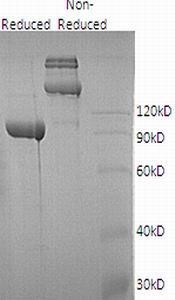Recombinant Human Fibroblast Growth Factor 1/FGF-1/FGFa (Phe16-Asp155)
Shipping Info:
For estimated delivery dates, please contact us at [email protected]
| Amount : | 50 µg |
| Content : | Lyophilized from a 0.2 µm filtered solution of 20mM Tris, 400mM NaCl, 1mM DTT, pH 8.0, The ED50 for this effect is less than 2 ng/ml, measured in a cell proliferation assay using BALB/c 3T3 cells. |
| Storage condition : | Lyophilized protein should be stored at -20°C, though stable at room temperature for 3 weeks. Reconstituted protein solution can be stored at 4-7°C for 2-7 days. Aliquots of reconstituted samples are stable at -20°C for 3 months. |
| AA sequence : | MFNLPPGNYKKPKLLYCSNGGHFLRILPDGTVDGTRDRSDQHIQLQLSAESVGEVYIKSTETGQYLAMDTDGLLYGSQTPNEECLFLERLEENHYNTYISKKHAEKNWFVGLKKNGSCKRGPRTHYGQKAILFLPLPVSSD |
Source: E. coli.
MW :15.9kD.
Recombinant Human Fibroblast growth factor 1 is produced by our E.coli expression system and the target gene encoding Phe16-Asp155 is expressed. FGF acidic, also known as ECGF, FGF-1and HBGF-1, is a non-glycosylated heparin binding growth factor that is expressed in the brain, kidney, retina, smooth muscle cells, bone matrix, osteoblasts, astrocytes and endothelial cells. It is a mitogenic peptide that is produced by multiple cell types and stimulates the proliferation of cells of mesodermal, ectodermal, and endodermal origin. Its association with heparan sulfate is a prerequisite for activation of FGF receptors. Internalized FGF acidic migrates to the nucleus where it is phosphorylated by nuclear PKC delta, exported to the cytosol, dephosphorylated, and degraded. Intracellular FGF acidic inhibits p53 activity and proapoptotic signaling.
MW :15.9kD.
Recombinant Human Fibroblast growth factor 1 is produced by our E.coli expression system and the target gene encoding Phe16-Asp155 is expressed. FGF acidic, also known as ECGF, FGF-1and HBGF-1, is a non-glycosylated heparin binding growth factor that is expressed in the brain, kidney, retina, smooth muscle cells, bone matrix, osteoblasts, astrocytes and endothelial cells. It is a mitogenic peptide that is produced by multiple cell types and stimulates the proliferation of cells of mesodermal, ectodermal, and endodermal origin. Its association with heparan sulfate is a prerequisite for activation of FGF receptors. Internalized FGF acidic migrates to the nucleus where it is phosphorylated by nuclear PKC delta, exported to the cytosol, dephosphorylated, and degraded. Intracellular FGF acidic inhibits p53 activity and proapoptotic signaling.
Always centrifuge tubes before opening. Do not mix by vortex or pipetting. It is not recommended to reconstitute to a concentration less than 100 µg/ml. Dissolve the lyophilized protein in ddH2O. Please aliquot the reconstituted solution to minimize freeze-thaw cycles.
Endotoxin : Less than 0.1 ng/µg (1 IEU/µg) as determined by LAL test.
For Research Use Only. Not for use in diagnostic/therapeutics procedures.
| Subcellular location: | Secreted, Cytoplasm, Cytoplasm, Cytoplasm, Nucleus |
| Post transnational modification: | In the nucleus, phosphorylated by PKC/PRKCD. |
| Tissue Specificity: | Predominantly expressed in kidney and brain. Detected at much lower levels in heart and skeletal muscle. |
| BioGrid: | 108537. 26 interactions. |
|
There are currently no product reviews
|















.png)









